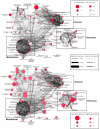Genetic Predisposition for Immune System, Hormone, and Metabolic Dysfunction in Myalgic Encephalomyelitis/Chronic Fatigue Syndrome: A Pilot Study
- PMID: 31179255
- PMCID: PMC6542994
- DOI: 10.3389/fped.2019.00206
Genetic Predisposition for Immune System, Hormone, and Metabolic Dysfunction in Myalgic Encephalomyelitis/Chronic Fatigue Syndrome: A Pilot Study
Abstract
Introduction: Myalgic Encephalomyelitis/ Chronic Fatigue Syndrome (ME/CFS) is a multifactorial illness of unknown etiology with considerable social and economic impact. To investigate a putative genetic predisposition to ME/CFS we conducted genome-wide single-nucleotide polymorphism (SNP) analysis to identify possible variants. Methods: 383 ME/CFS participants underwent DNA testing using the commercial company 23andMe. The deidentified genetic data was then filtered to include only non-synonymous and nonsense SNPs from exons and microRNAs, and SNPs close to splice sites. The frequencies of each SNP were calculated within our cohort and compared to frequencies from the Kaviar reference database. Functional annotation of pathway sets containing SNP genes with high frequency in ME/CFS was performed using over-representation analysis via ConsensusPathDB. Furthermore, these SNPs were also scored using the Combined Annotation Dependent Depletion (CADD) algorithm to gauge their deleteriousness. Results: 5693 SNPs were found to have at least 10% frequency in at least one cohort (ME/CFS or reference) and at least two-fold absolute difference for ME/CFS. Functional analysis identified the majority of SNPs as related to immune system, hormone, metabolic, and extracellular matrix organization. CADD scoring identified 517 SNPs in these pathways that are among the 10% most deleteriousness substitutions to the human genome.
Keywords: genome-wide; hormone; immune system; metabolic; myalgic encephalomyelitis/chronic fatigue syndrome; single-nucleotide polymorphism.
Figures
References
LinkOut - more resources
Full Text Sources


